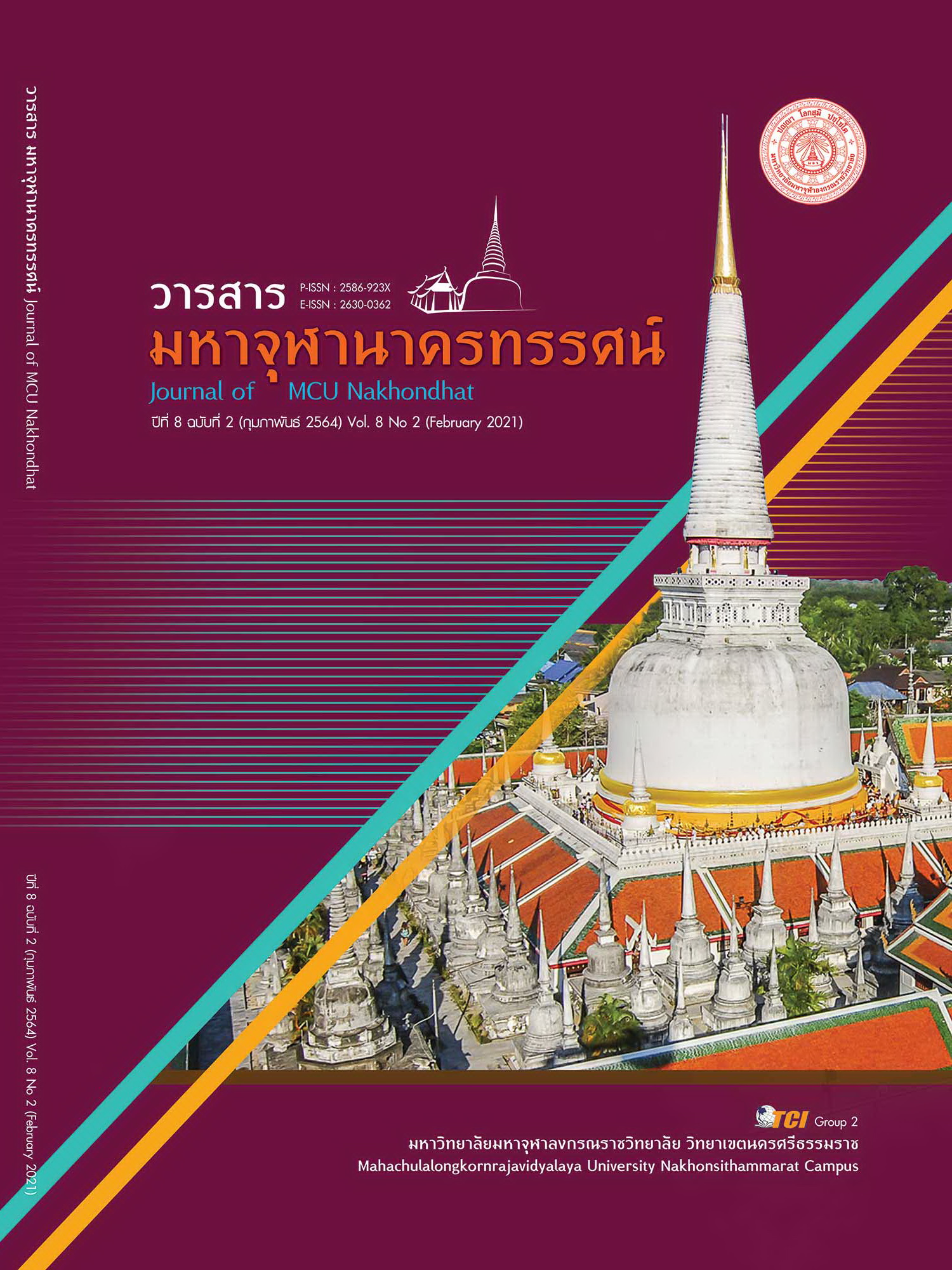AN EVALUATION OF PROMOTING ACTIVE LEARNING PROJECT IN THOENG WITTAYAKHOM SCHOOL, THE SECONDARY EDUCATIONAL SERVICE AREA OFFICE 36
Main Article Content
Abstract
This objectives of research article were to evaluate the promoting active learning project in Thoeng Wittayakhom School, The Secondary Educational Service Area Office 36 by using CIPPI model. Data were collected from 821 samples in the academic year 2018 consist of school administrators, teachers, school committee, parents and students, through the questionnaires and were analyzed by using the descriptive statistics: mean and standard deviation. The findings showed that: the evaluation of the projects in overall was at the highest level that pass evaluation criteria as follows: 1) the project’s context evaluation results showed the objectives, goals, operation process, and measurement of the project was clear that focus to develop learners to have higher academic achievement and learning skills in the 21st century including to create proactive learning management for teachers. 2) the projects’ input evaluation results showed the project committees were appropriate and sufficient for the implementation of the project. 3) The project’s process evaluation results showed teachers carry out proactive learning management activities in school was at the highest level. 4) The project’s products evaluation results showed the teachers had knowledge understanding, skills and experiences toward active learning management in overall was at the highest level and they designed and developed active learning lesson plan for teaching in the academic year 2018, total 124 subjects. 5) And the project’s impacts evaluation results showed the teachers do the action research in their classroom for solving the students learning problems, the students had using technology skills for creating, designing, presentation, and publish to the public at local, regional and national levels were at the highest level and the projects’ satisfaction evaluation in the overall was at the highest level.
Article Details
References
ทวีวัฒน์ วัฒนกุลเจริญ. (2551). การเรียนเชิงรุก (Active learning). เรียกใช้เมื่อ 22 สิงหาคม 2562 จาก http://blog.eduzones.com/images/blog/sasithep/File/activet. pdf
ธรรมรัตน์ เม่งพัฒน์ และประเสริฐ ประวัติรุ่งเรือง. (2558). การประเมินโครงการพัฒนากิจกรรมการเรียนรู้แบบ Active Learning มหาวิทยาลัยนอร์ทกรุงเทพ. ปทุมธานี: มหาวิทยาลัยนอร์ทกรุงเทพ.
มาเรียม นิลพันธุ์ และคณะ. (2559). การประเมินโครงการพัฒนาวิทยากรแกนนำการจัดการเรียนการสอนวิชาวิทยาศาสตร์เป็นภาษาอังกฤษ เพื่อเตรียมความพร้อมการจัดการเรียนการสอนในรูปแบบ English Bilingual Education (EBE) ระดับมัธยมศึกษาตอนต้น (กลุ่มการพัฒนา ณ ประเทศสิงคโปร์) ตามโครงการความร่วมมือระหว่างสำนัก. Veridian E-Journal, Sulpakorn University ฉบับภาษาไทย สาขามนุษยศาสตร์ สังคมศาสตร์ และศิลปะ, 9(2), 2268-2285.
รมย์ พะโยม. (2557). การประเมินโครงการการพัฒนาคุณภาพการศึกษาเพื่อยกระดับผลสัมฤทธิ์ทางการเรียน ของสำนักงานเขตพื้นที่การศึกษาประถมศึกษากำแพงเพชร เขต 2. สักทอง. วารสารมนุษยศาสตร์และสังคมศาสตร์, 20(3), 7-19.
รุ้งลาวัลย์ จันทรัตนา และคณะ. (2559). การประเมินโครงการจัดตั้งห้องเรียนพิเศษ Science and Mathematics Program (SMP) มหาวิทยาลัยราชภัฎยะลา. ยะลา: มหาวิทยาลัยราชภัฎยะลา.
วัชรา เล่าเรียนดี และคณะ. (2560). กลยุทธ์การจัดการเรียนรู้เชิงรุก เพื่อพัฒนาการคิดและยกระดับคุณภาพการศึกษา สำหรับศตวรรษที่ 21. นครปฐม: เพชรเกษมพริ้นติ้ง กรุ๊ป.
วัชรี เกษพิชัยณรงค์ และคณะ. (2555). การเรียนเชิงรุกและเทคนิควิธีการจัดการเรียนการสอนที่เน้นการเรียนเชิงรุก. กรุงเทพมหานคร: สถาบันนวัตกรรมการเรียนรู้ มหาวิทยาลัยมหิดล.
สำนักงานรับรองมาตรฐานและประเมินคุณภาพการศึกษา (องค์การมหาชน). (2554). คู่มือการประเมินคุณภาพภายนอกรอบสาม (พ.ศ.2554-2558) ระดับการศึกษาขั้นพื้นฐานฉบับสถานศึกษา (แก้ไขเพิ่มเติม พฤศจิกายน 2554). สมุทรปราการ: ออฟเซ็ท พลัส.
สิทธิพงษ์ สุพรม. (2561). การพัฒนาความสามารถในการเรียนรู้เชิงรุกในศตวรรษที่ 21 สำหรับนักเรียนชั้นมัธยมศึกษาตอนต้น. วารสารวิจัยและประเมินผลอุบลราชธานี, 7(2), 49-58.
สุพักษ์ สมสา. (2560). การพัฒนารูปแบบการพัฒนาสมรรถนะการจัดการเรียนรู้เชิงรุกของครู โรงเรียนบ้านโคกคุง สำนักงานเขตพื้นที่การศึกษาประถมศึกษามหาสารคาม เขต 1. มหาสารคาม: สำนักงานเขตพื้นที่การศึกษาประถมศึกษามหาสารคาม เขต 1.
สุภัทรา ภูษิตรัตนาวลี. (2560). การพัฒนารูปแบบการจัดการเรียนรู้เชิงรุกสำหรับคณาจารย์วิทยาลัยเทคโนโลยีภาคใต้. ใน ดุษฎีนิพนธ์ปรัชญาดุษฎีบัณฑิต (สาขาการวิจัยพฤติกรรมศาสตร์ประยุกต์). มหาวิทยาลัยศรีนครินทรวิโรฒ.
เอกรัตน์ รวยรวย และคณะ. (2558). เทคนิค 5 ประการของกระบวนการ เพื่อเปลี่ยนห้องเรียนไปสู่การจัดการเรียนรู้เชิงรุก. ใน การประชุมวิชาการครุศาสตร์อุตสาหกรรมระดับชาติ ครั้งที่ 8. คณะครุศาสตร์อุตสาหกรรม มหาวิทยาลัยเทคโนโลยีพระจอมเกล้าพระนครเหนือ.
Bonwell, C. C & Eison, J. A. (1991). Active learning: Creative Excitement in the Classroom. ASHE-ERIC Higher Education Report. Washington DC: School of Education and Human Development, George Washington University.
Drits-Esser, D. & Stark, L. A. (2015). The Impact of Collaborative Curriculum Design on Teacher Professional Learning. Electronic Journal of Science Education, 19(8), 1-27.
McConnell, D. A. et.al. (2017). Instructional Utility and Learning Efficacy of Common Active Learning Strategies. Journal of Geoscience Education, 65(4), 604-625.
Sheffield Hallam University. (2000). Active Teaching and Learning Approaches in Science: Workshop ORIC Bangkok. Sheffield: Sheffield Hallam University.
Stufflebeam, D. L. & Shinkfield, A. J. (2007). Evaluation Theory, Models and Applications. San Francisco, CA: Jossey-Bass.
Stufflebeam, D. L. et al. (2002). The Spirit of Consuelo: An Evaluation of Ke Aka Ho'ona. Michigan: The Evaluation Center, Western Michigan University.

